10 things to do in the Vatican
There are not that many countries in the world where you do not need a visa—or even a passport—to cross the border, but the Vatican is one of those places. The smallest state in the world in terms of both area and population, the Vatican occupies only 44 hectares in West Rome. Surrounded by Medieval and Renaissance-era walls, the state is the official seat of the Catholic Church and the Pope.
However, the Vatican was not always the Pope’s official residency. During most of the Papal States’ existence (754–1870), the popes did not live in the Vatican. Initially, they resided at the Lateran Palace, on the opposite side of Rome. Then, from 1309 to 1377, they lived at Avignon in France, and after their return to Rome they settled in the Quirinal Palace, waiting for the construction works to be completed at the Vatican. After Italy’s unification, however, the Pope lost the Quirinal Palace to the King of Italy and was forced to move to the Vatican. Until 1929 the Popes refused to acknowledge the power of the King of Italy and leave Vatican grounds. Only in February 1929 was the agreement between the Kingdom of Italy and the Holy See finally signed, establishing the independent state of the Vatican. As the spiritual centre of the Catholic world today, the Vatican attracts not only devoted pilgrims, but also art and history enthusiasts.
1 - Be welcomed by the ‘arms of the Church’ on St Peter’s Square
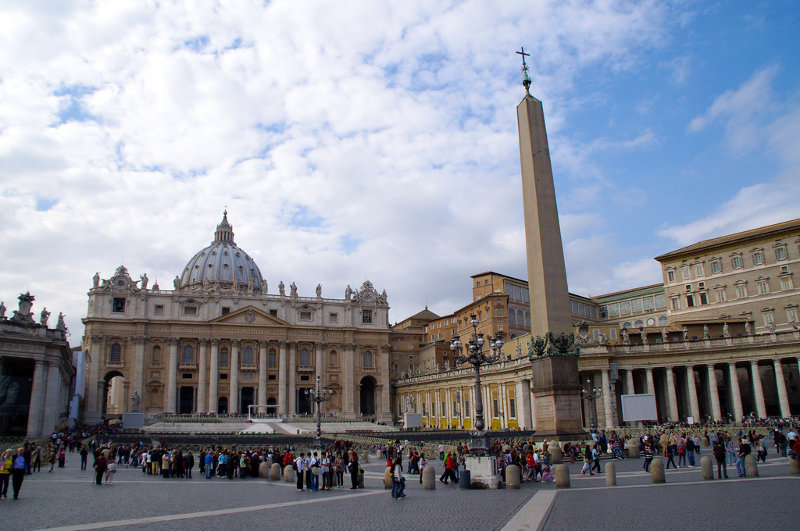
St Peter's Square / Courtesy stevekc/Flickr.com
Today Via della Conciliazione is the most popular route to the Vatican and St Peter’s Square. However, before the Medieval quarters in this area were demolished by Mussolini in 1930s to make space for Via della Conciliazione, pilgrims used to reach St Peter’s square through narrow streets. For them, entering the light and glorious square felt as a revelation after a long journey. For a glimpse of an authentic Baroque experience, take Borgo Santo Spirito and be amazed by the expanse of the square, unexpectedly opening in front of you.
The square as can be seen today was designed during 1656 - 1667 by Gian Lorenzo Bernini (1598 – 1680), one of the major Baroque architects. It was commissioned by Pope Alexander VII as a part of his campaign to re-plan the city to create a space where as many people as possible could see the Pope giving his blessing from the balcony. This tradition still takes place there every Wednesday.
The result is a perfectly symmetrical design shaped as ‘ovato tondo’, a round oval with its long axis parallel to the Basilica’s facade, and framed by the colonnade. The centre of the square is marked by an Egyptian obelisk, which was erected there in 1568 after being transported from Egypt to Rome in 37 AD. Here, Bernini turns the obelisk into the gnomon (or pointer) of a sundial, which accurately indicates midday and the two solstices together with a marble line and markers embedded in the pavement of the square.
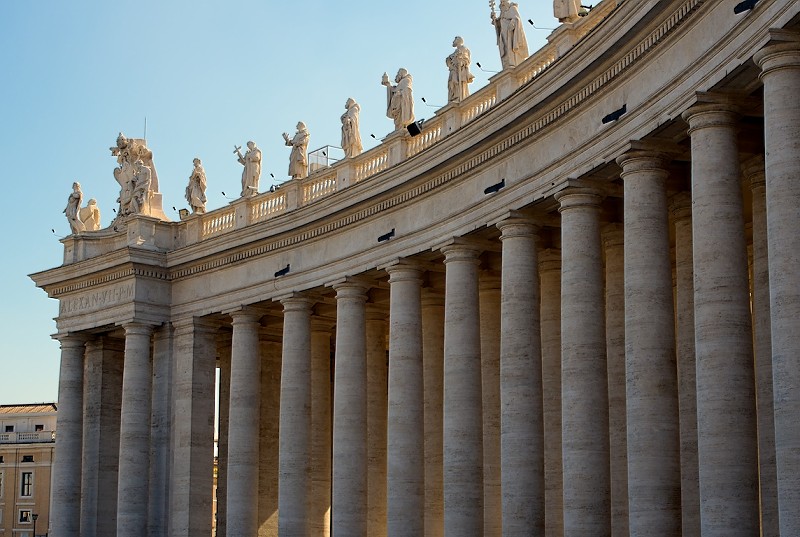
Colonnade on St Peter's Square / Courtesy Wikipedia
The colonnade is one of the most impressive features of the square, creating an illusion of arms wide-open representing the Catholic Church welcoming every visitor. Each symmetrical colonnade is four columns deep and surrounds the trapezoidal way to the basilica along with the grand elliptical square that precedes it. Inside, the colonnades have three continuous passages: two for pedestrians and one for carriages. Baroque architecture is famous for its love of optical illusions and theatricality, and this square is no exception. If you stand on one of the centre points at each side of the colonnade, you will see only one column in each row instead of four.
2 - Be amazed by the splendour of St Peter’s Basilica’s interiors

Interior of St Peter's Basilica / Courtesy Scott Sherrill-Mix/Flickr.com
St Peter’s square is an architectural masterpiece in itself, but its ultimate goal is to draw the visitors inside of the imposing St Peter’s Basilica. The largest church in the world, it was designed by major architects of the Italian Renaissance and Baroque. According to legend, the Basilica is built on the location where the apostle St Peter, who is considered the first Pope, was crucified as a martyr and buried in 64 AD. The first building of the Basilica dates back to Emperor Constantine in the fourth century AD, and was a smaller version of the church we see today, which accounts for 22,300 sq m with a capacity for 60,000 people.
The restoration and expansion of the Basilica started in the middle of the 15th century, but due to the architect’s death it was realised only half a century later. Pope Julius II (1443 - 1513) invited Donato Bramante (1444 - 1514), an Italian architect of the High Renaissance period, to propose a design for the Basilica. Bramante designed a new structure with a Greek floor plan and an enormous dome. As the work progressed, Michelangelo designed the current dome and the facade, which was later altered by Carlo Moderno.
Before entering the Basilica, notice the five doors, which correspond to the five naves of the ancient and new buildings of the church. The last doors to the right are called ‘The Holy Doors’ and are opened only during the Jubilee Years, usually held every twenty-five years. During this time of grace, hope, and joy pilgrims can go through the Doors to piously gain the plenary indulgences as a part of the Jubilee year celebrations. The last time the Holy Doors were opened was from 8 December 2015 to 20 November 2016.
Step inside the church and be amazed by the richness of its interior. Wander around the central nave, the nave of Epistle, or the Gospel nave, which are separated by large pillars. Marvel at the splendour of the marble and gold decorations, the intricate mosaics from the ancient Basilica, and the numerous works of art that are housed in the church. As you walk around, you may notice the special marks on the floor that indicate the lengths of the largest churches in the world for comparison.
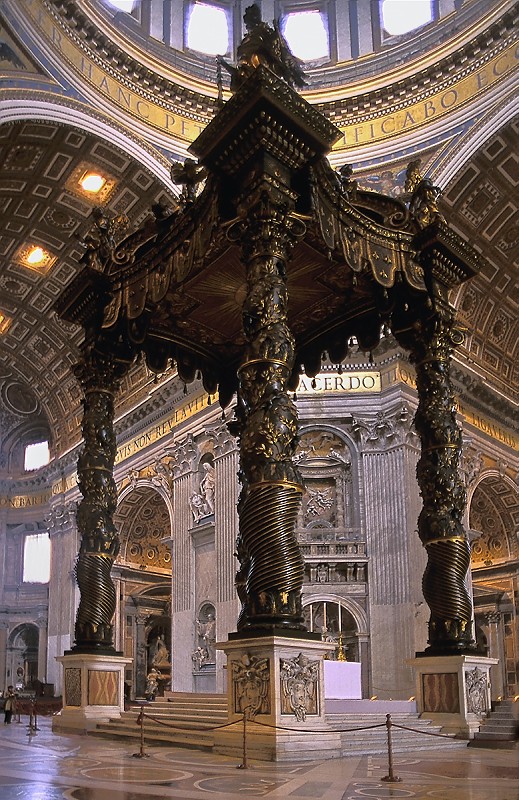
Bernini's Baldacchino / Courtesy Wikipedia
The focal point of the church’s interior is The Papal Altar, placed over the tomb of St. Peter. The Altar is easily identified due to its grandiose baldacchino, a large Baroque bronze canopy, completed by Bernini in 1634. This 20 meter tall baldachin was the first of Bernini’s works in which he brought sculpture and architecture together. It consists of four helical columns, each based on a high marble plinth. The columns support a cornice, curving inwards in the middle of each side, and the overall construction is topped by four twice life size angels, standing at the corners. Behind them there is a second smaller cornice which supports the gilded cross on a sphere, a representation of the world governed by Christianity.
In designing the dome of St Peter’s Basilica, Michelangelo was inspired by the massive dome of the ancient Pantheon in Rome. Positioned immediately under the Basilica’s dome, Bernini’s baldacchino strengthens this connection, using the original bronze decorations from the Pantheon in crafting his canopy.
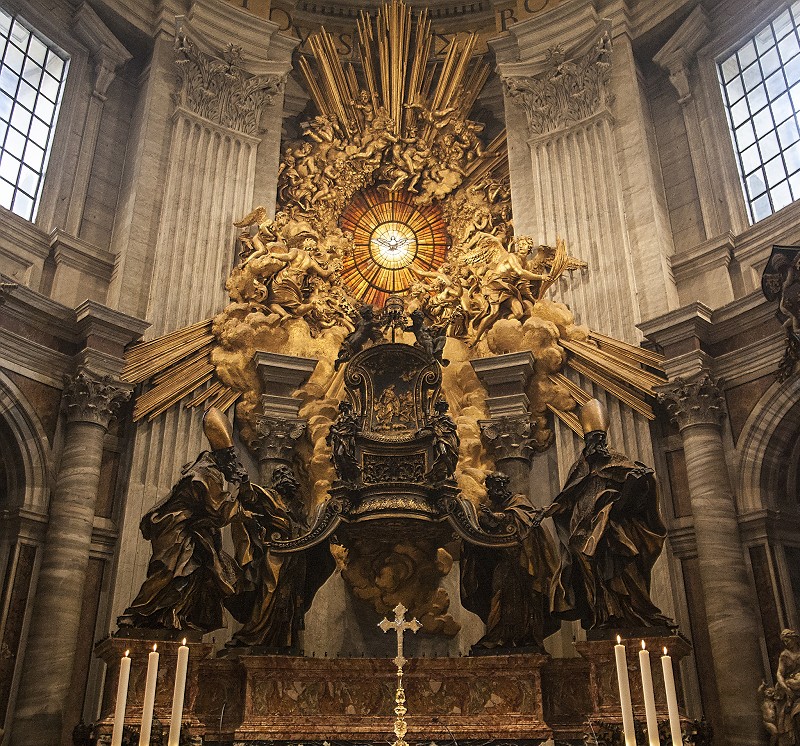
The Altar of the Chair of Peter / Courtesy Wikipedia
Further towards the end of the central nave you will find another important Christian relic - The Altar of the Chair of Peter. Also designed by Bernini and completed in 1666, this impressive sculptural monument was created to carry the wooden throne of St Peter. The marble base is flanked by four gigantic statues of Doctors of the Church, the early Christian theologians: St. Ambrose, St. Athanasius (left); and St. John Chrysostom, St. Augustine (right). Above the casket with the Chair are two angels with a tiara and keys, symbols of papal authority. The composition is topped by an alabaster window with a dove as a symbol of the Holy Spirit and the light of Christianity.
St Peter’s Basilica is one of the most extraordinary buildings in the world, but it is also a functional church, so it is important to remember some rules to fully enjoy your visit:
- The admission to the Basilica is free, but there are also optional paid visits (the dome, the treasure, etc.).
- The Basilica is open everyday from 7am to 7pm (April to September) and from 7am to 6pm (October to March).
- There is frequently a line to get inside the Basilica, so it is advisable to arrive earlier. However, you can skip the line if you get a guided tour to the Vatican Museums, which ends in the Basilica.
- The Basilica is a church, not a museum, so remember to dress properly: no bare shoulders, shorts or short skirts.
- Once you passed the security check before entering to the church, make use of the visitor centre with a cloakroom for large bags, public toilets, and audio guide rental.
3 - Feel compassion with Michelangelo’s Pietà
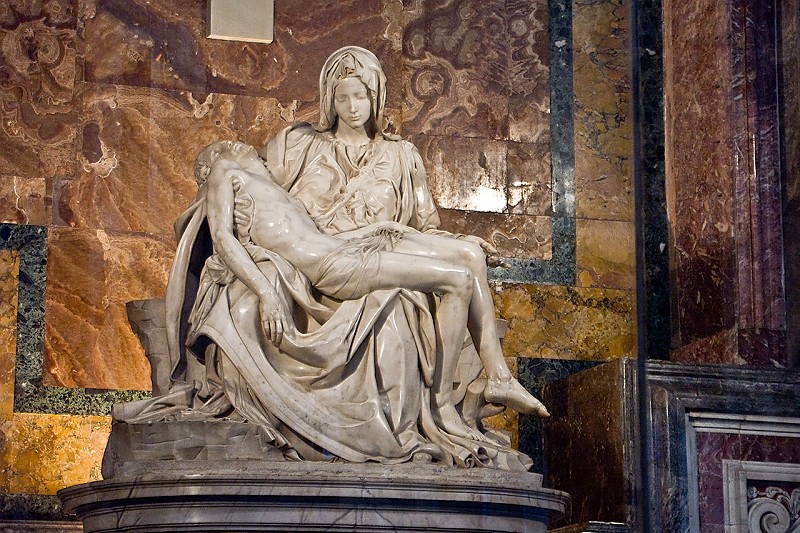
Pietà (1499) by Michelangelo / Courtesy Wikipedia
It is easy to be dazzled by the splendor of the Basilica’s interior and overlook the works of art in its chapels. If you want to make the most out of your visit, there is one work you cannot miss - the Pietà (Compassion) by Michelangelo in the first chapel of the right aisle. It was commissioned by a French cardinal, Jean de Billheres, who asked Michelangelo to produce ‘the most beautiful work of marble in Rome, one that no living artist could better’ to make a memorial for his tomb.
Created in 1499 when the artist was only 24 years old, this Renaissance masterpiece is a marble statue of the Madonna cradling the dead Christ’s body on her lap. Her delicate face is full of grief and submission to destiny, while the voluminous drapery of her dress creates an illusion of physical and moral strength. Don’t be surprised by the youthful look of the Madonna: doing this Michelangelo wanted not only to depict the moment of the Christ’s death, but at the same time show that Madonna foresaw the upcoming events from the beginning.
Pietà is the only one of Michelangelo’s works ever signed by the artist. Shortly after the presentation of the sculpture Michelangelo overheard that people attributed it to another artist and rushed to inscribe a small ribbon across the Madonna’s chest: ‘Michelangelo Buonarroti, Florentine, Maker’. However, afterwards the artist became ashamed of his vanity and vowed not to sign any of his future works.
Pietà has always attracted the attention of academics and the general public, whether because of its incredible marble work, or the artist’s dramatic interpretation of the scene. Unfortunately, it also attracted an act of violence in 1972, when unemployed geologist Laszlo Toth attacked the statue with a hammer, causing some serious damage to the work. This incident is the reason why today the Pietà is protected by a bulletproof glass.
4 - Admire Rome and St Peter’s Square from above
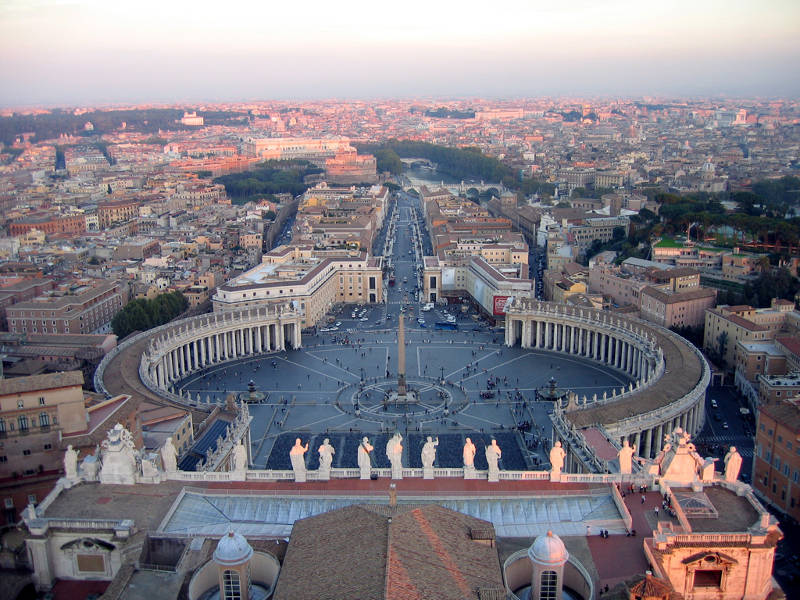
St Peter's Square from above / Courtesy Christopher Lance/Flickr.com
Located on the Vatican Hill, St Peter’s Basilica is the tallest building in the city, and its dome (cupola) is visible from any place in Rome. The dome was designed by Michelangelo in the 16th century and reaches a maximum height of 135m at the top and 42m in diameter. The artist intentionally made it 1.5m in diameter shorter than the dome of the Pantheon, saying ‘I could build one bigger, but not more beautiful, than that of the Pantheon.’
You can climb the cupola and enjoy the panoramic view of the square and the Vatican Gardens. It is open to the public from 8am to 5pm in winter and 8am to 6pm in summer. You can choose to climb all the way up for €6 or take an elevator for €8. The box office, the entrance to the lift, and staircase are inside the Basilica, on the right, with the sign ‘Cupola’.
Whether you take a lift or the staircase, you first stop will be an interior balcony which serves as the base of the dome. Take a break and look at the decoration of the dome’s interior, the gleaming mosaics or the grand layout of the Basilica from above. When you are ready to move on, start climbing the spiral staircase leading to the upper area. Otherwise, go down a few steps to the terrace overlooking St. Peter’s square. Here you will also find bathrooms, a water fountain, a souvenir shop, and a café.
While on top, notice the wide straight avenue, Via delle Conciliazione, connecting the Vatican with Castel Sant’Angelo. Construction of this road in 1936 was Benito Mussolini’s controversial decision, which led to the demolition of the entire medieval quarter, and to creating a direct access to Castel Sant’Angelo.
5 - Visit the tomb of St Peter in the Necropolis
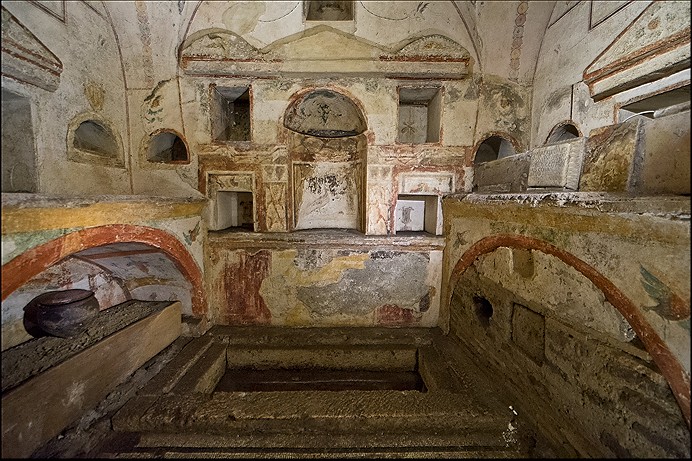
The Vatican Necropolis / Courtesy Wikipedia
The catacombs are a unique feature of Roman landscape and history, and the Vatican has its own underground system of tombs and chapels dating back to the times of Emperor Nero in AD 64. A burial place for Christians who had been executed, including the apostle Peter himself, the catacombs were hidden underneath the newly constructed St Peter’s Basilica in 319 under Emperor Constantine.
The excavations and exploration of the Necropolis started only in 1949 in search of the remains of St Peter, and today you can visit two levels of the perfectly preserved catacombs. The Vatican Grottoes have the tombs of kings, queens, and popes from the 10th century onwards, while the Necropolis is located one level down and dates back to the time before Constantine.
While the admission to the Grottoes is free, you will need to book a special tour to see the Necropolis. During this 1.5 hour visit you will see 22 mausoleums of wealthy families, which decoration reflects the transitional period from paganism to Christianity with depictions of Dionysus and Bacchus. The highlight of the tour is the so-called field ‘P’, a small square paved with mosaics and located immediately under the Papal Altar of the present Basilica. On the right side you can find the place where the human remains and a fabric with gold threads were found. The Greek inscription ‘Petro Eni’ (‘Peter is here’) nearby suggests that it was the burial place of St Peter.
Due to the restricted access to the Necropolis (up to 250 visitors per day), your visit should be booked well in advance online or in person at the Office of Excavations in the Vatican, at the south entrance (left side) just outside St Peter’s Square colonnade. The Office is also the beginning of the tour, where you will present the printed booking confirmation to the Swiss Guard on the day of your booking. Only visitors 15 years of age and older are allowed into the Necropolis.
6 - Send a postcard from the Vatican
Whether you are looking for a nice souvenir for your stamp-collector friend or want to share your travel stories with your family back home, do not miss the Vatican’s post office. You can send your postcards and letters from the main office or visit a mobile post-office truck, located in St Peter’s square. Many Romans rely on the Vatican postal system more than on the capricious Italian post, and make a special trip to the city-state to send important correspondence. Add all the tourists and church officials who use the Vatican’s postal services every day, and you will see that there are more letters sent each year, per inhabitant, from the Vatican than from anywhere else in the world.
The postal office of the smallest country in the world opened shortly after the Vatican’s official foundation in 1929. Produced under the authority of the Philatelic and Numismatic Office of the Vatican City State, the stamps are frequently issued in limited quantities with the average production ranging between 300,000 and 500,000 stamps. Especially rare and valuable are ‘sede vacante’ stamps, which are only produced during the time between the death or resignation of one Pontiff and the election of another.
The main post office is open from 8am to 6:45pm, Monday to Friday, and from 8am to 2pm on Saturday, while the postal truck on the square is open from 8:30am to 6:30pm from Monday to Saturday.
7 - Meet the Pope’s personal bodyguards
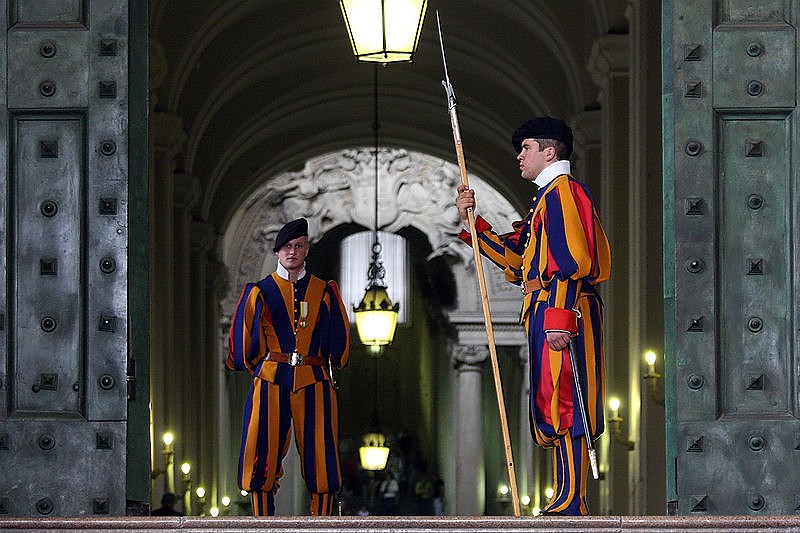
Swiss Guards at the Vatican / Courtesy Wikipedia
Even a short visit to the Vatican will not be complete without meeting the Swiss Guard, the Pope’s personal bodyguards. Dressed in a bright blue, red, orange, and yellow uniform, they might be seen as a theatrical addition to your Vatican experience, but in reality they are a well-trained standing army of the city-state.
Founded in 1506 upon the request of Pope Julius II, today it is the smallest professional army in the world with about 110 soldiers. It is not a surprise that only a Swiss national can join the Swiss Guard. To be considered, applicants have to be single Catholics, have completed training in the Swiss military, be between 19 and 30 years of age, and be at least 174 cm tall.
The guard’s costumes became a recognisable feature of the Vatican’s image, though their current model was introduced only in 1914 by commandant Jules Repond, inspired by 16th-century depictions of the Swiss Guard. To create an unmistakably Renaissance outfit, Repond combined blue and yellow from the original 16th-century costumes (representing the Della Rovere coat of arms of Julius II), with red for the Medici family coat of arms of Leo X, the second Pope protected by the Swiss Guard.
8 - Visit the largest art collection in the world at the Vatican Museums
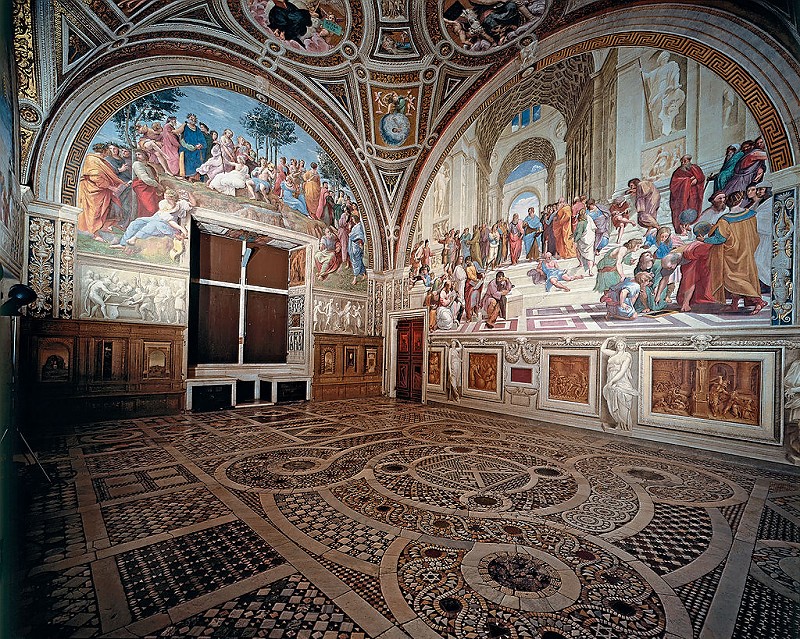
Raphael Rooms at the Vatican Museums / Courtesy Wikipedia
The Catholic Church is one of the most powerful institutions in the world, and has developed over the centuries not only through spreading the Christian faith around the world, but also through amassing the largest collection of art. The initial collection has been receiving further additions and extensions during the last five centuries, with art collections ranging from ancient Egypt to the twentieth century. The masterpieces inside of St Peter’s Basilica, the collection of at least half a million books and manuscripts, the world’s leading cartographic collection, all of this is enriched by rooms full of paintings, murals, and sculptures which can be found in the Vatican Museums today.
The most famous and popular museum in the Vatican is the Pinacoteca Vaticana, the Vatican’s picture gallery. The collection was started by Pius VI (1775-1799), but its current building was completed only in 1931, and it houses today works from the Middle Ages to 1800, set in chronological order. Here you will find masterpieces by Giotto, Fra Angelico, Raphael, Leonardo, Caravaggio, and others. The collection of Modern art was opened in the 1970s and presents works by Bacon, Chagall, Dali, Paul Gauguin, Kandinsky, Matisse, and Van Gogh, among others. Another famous Vatican Museum is Museo Pio-Clementino, a collection of Greek and Roman sculptures, including Apollo Belvedere, Laocoön and His Sons, and Afrodita Cnidia. The Gregorian Egyptian Museum has Egyptian, Assyrian, and Mesopotamian works mostly sourced from Hadrian’s Villa in Tivoli. If you are eager to see more, there is also the Etruscan Museum, the Ethnological Museum (gifts to the Pope), the Pious Christian Museum, and the Philatelic and Numismatic Museums.
The visit rooms are another important part of the Vatican Museums and the state’s history. At some point these were the apartments of Pope Julius II (1503-1513), who decided not to live in the rooms inhabited by his predecessor Alexander VI. He commissioned Raphael (1483-1520) to decorate these rooms, and he created his frescoes on top of already existing works by other artists. Today, you can visit the Loggia of Raphael and the four rooms decorated by Raphael with beautiful frescoes, including The School of Athens and the Disputation of the Holy Sacrament. Do not miss the Immaculate Conception Room by Francesco Podesti (1800-1895).
If you feel you need a break from art, escape to the outdoor areas of the Vatican Museums and enjoy some fresh air. Today there are three inner courtyards: the Courtyard of the “Pigna”, the Library Courtyard, and the Courtyard of the “Belvedere”. Belvedere courtyard is the oldest one, created by Donato Bramante in 1506 to connect the Palace of Innocent VIII (1484-1492) with the Sistine Chapel, built by Sixtus IV (1471-1484). However, in the end of the 16th century Sixtus V (1521 - 1590) erected a wing of the Vatican Library, dividing the courtyard into two parts. The Pigna (Pine) courtyard is one of those parts and the only Vatican courtyard open to the public today. It got its name from the oversized niche containing a 1st-century BC, 13-foot-high bronze cone that was discovered in the Baths of Agrippa. The Vatican collection is constantly acquiring new works by contemporary artists, and the shiny Sphere within a sphere (1990) by Arnaldo Pomodoro installed in the Pigna courtyard is one of such examples.
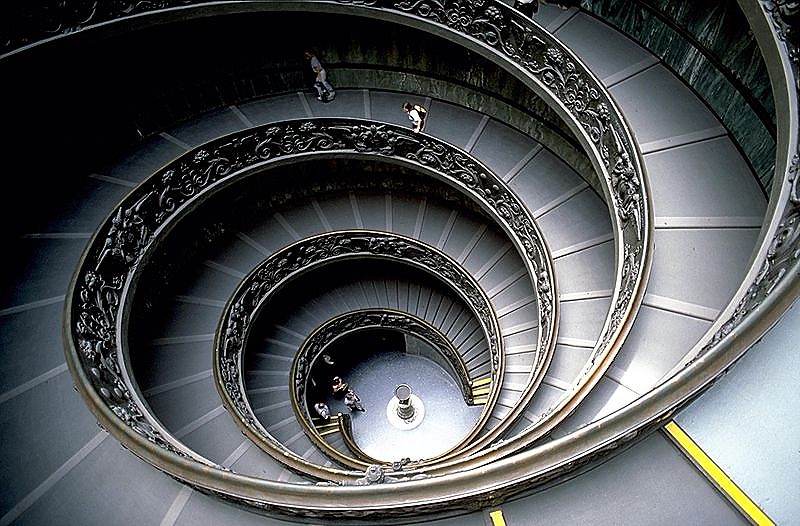
Giuseppe Momo’s Spiral Staircase / Courtesy Wikipedia
The Vatican Museums always offer something to admire, even as you are leaving the museums. Giuseppe Momo’s Spiral Staircase (1932) may be one of the most photographed staircases in the world, drawing its inspiration from the High Renaissance genius of Bramante, who designed Pio-Clementine Museum’s Bramante Staircase, which is not open to the public. Momo’s staircase has the same double helix structure, allowing people to ascend and descend without meeting each other. Here, the architect created an intriguing optical illusion, and from the top the structure appears longer than it really is.
The vast collections of the Vatican Museums attract thousands of people everyday, and you need to plan your visit well in order to avoid long lines or crowds. Visit the official Museum’s website for more details on the tickets and opening times, and book your tickets in advance. With a printed ticket you will be able to skip the queue and go directly to enjoy the Museums’ collections.
If your decision to visit the Museums is spontaneous, try to avoid Wednesday, the day of the Papal audience, free entrance days (the last Sunday of the month and September 27th), or early morning from 9am to 12pm.
9 - Appreciate Michelangelo’s artistic deed in the Sistine Chapel
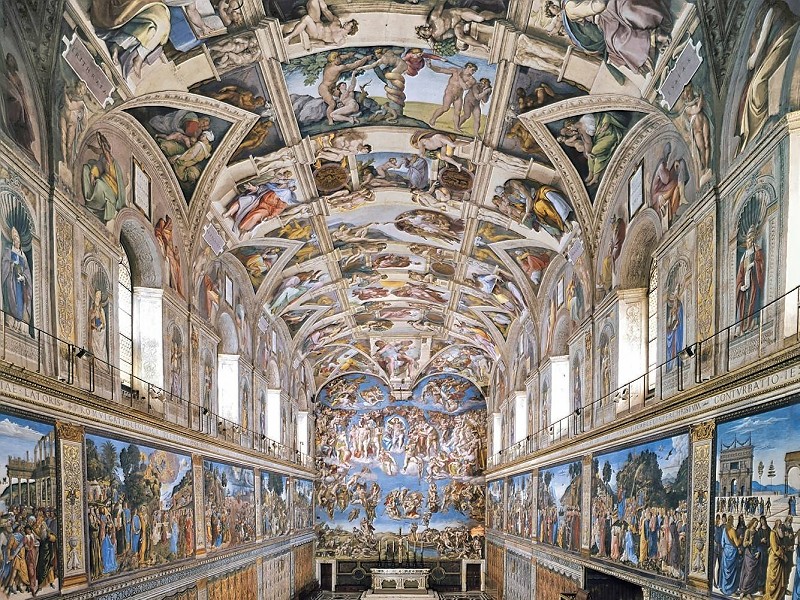
Sistine Chapel / Courtesy Wikipedia
The Sistine Chapel is one of the most visited cultural sites in the world. It got its name after Pope Sixtus IV (1471-1484), who commissioned a large room on the location of the Medieval fortified hall, the “Capella Magna”, used for assemblies. He also invited famous painters from Florence and Urbino, such as Botticelli, Ghirlandaio, Perugino, and Pinturicchio to decorate the chapel with frescoes. They worked on the side walls of the chapel, creating The Life of Moses and The Life of Christ. The lower level of the walls is decorated with realistically-looking frescoed hangings in silver and gold, adorned with papal crests. Previously, this lower part was covered with actual tapestries, designed by Raphael and his assistants, and today they can be seen at the Vatican Pinacoteca.
If you examine drawings from the 16th century that depict the chapel, you will be surprised to see that its ceiling was decorated with golden stars on a blue background. The famous ceiling with the scenes from the Book of Genesis was created by Michelangelo later, during 1508 - 1512. Today you can marvel upon famous scenes from the history of mankind before the coming of Christ, including the famous Creation of Adam, at the end of your visit to the Vatican Museums. Michelangelo also depicted sibyls and prophets, covering the entire ceiling, which is 40 meters long and 13 meters wide, with more than 300 figures in total.
The Last Judgement fresco (1535 to 1541) is another masterpiece by Michelangelo, covering the entire Chapel’s altar wall. It depicts the second coming of Christ on the Day of Judgement, and shows the development of the artist’s creative genius. In the upper part of the wall is the terrifying figure of Christ, with the saints hustling around him. The bottom left part of the fresco shows the dead raising from their graves and ascending to be judged, while the right part depicts those who are assigned to Hell and are dragged down by demons. Because of the unprecedented amount of nudity, and other controversial aspects which were seen as inappropriate for a space like the Sistine Chapel, this work was strongly criticised by the artist’s contemporaries. It led to a decision to paint drapery over the private parts of the figures, which, however, was removed during the Chapel’s restoration in the end of 20th century.
The Sistine Chapel is famous not only because of its incredible decoration, but as the home of the conclave that elects the Pope. For centuries, this room has been the place where important historical decisions have been made, and from where the fumata (white smoke announcing the new Pope) reveals the results of the papal elections. Because the Chapel is a functional space of Vatican, it can be closed for special occasions even when the rest of the museums are open. Check the official website for special announcements.
10 - Enjoy the art of landscape design at the Vatican Gardens
The best option to have a break from the hustle and bustle of the Vatican Museums is to enjoy the tranquillity of the Vatican Gardens. Whether you are a nature lover, or would like to learn more about the Vatican’s history, a visit to the gardens can be just what you need.
Back in 1279 Pope Nicolas III (died in 1280) decided to create his own secluded garden, separating the existing vineyards and meadows on the Vatican Hill with a massive brick wall. The gardens, comprising 32 hectares, are a charming example of landscape design, and include forests, Medieval monuments, sculptures, ponds, and many other attractions. Spring may be the best time to visit the gardens, when they are in full bloom. A joy for botany enthusiasts with Mediterranean pines, Lebanese cedars, and an olive tree, a gift from the State of Israel, the gardens also provide a unique glimpse into the daily life of the Vatican State. The gardens are accessible only with the guided tour, which will allow you to observe the maintenance and security services at work, visit the Vatican Radio, and meet with the famous family of cats living there.
The guided tour is about 2 hours long, and should be booked online. This can help you to save time and money, because the 32 Euro ticket also includes entry to the Sistine Chapel, and the Vatican Museums, where the tour ends.
This article was originally published on Routes.Tips.